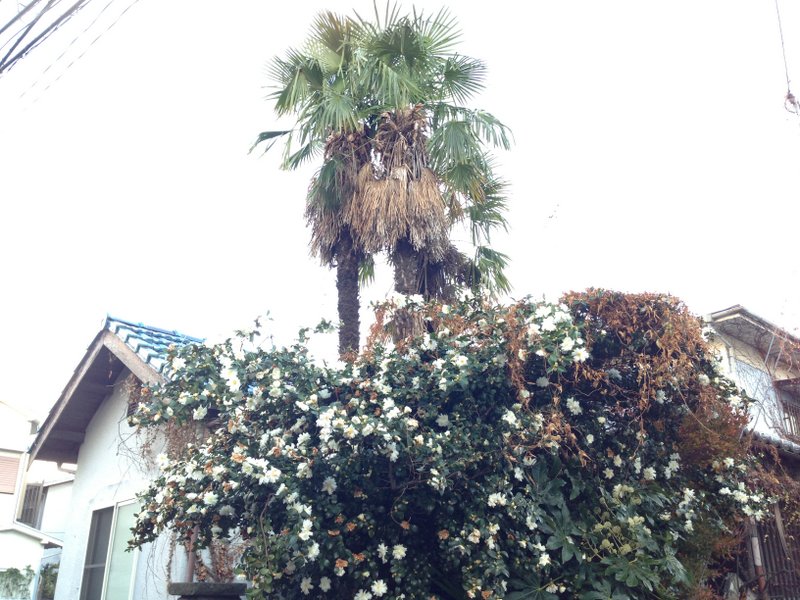
I love this winter scene of rampant white camellia and tall native palms, with plenty of dead fronds still attached to the crown. The wild landscape makes the house cozy and bright in the cold weather.

I love this winter scene of rampant white camellia and tall native palms, with plenty of dead fronds still attached to the crown. The wild landscape makes the house cozy and bright in the cold weather.

この盆栽の葉を見たとき、うれしかった。もう死んじゃったかと思いました。
I have lost a number of bonsai over the past two years. It was a pleasant surprise to see these little leaves appear. I need to replace the moss.
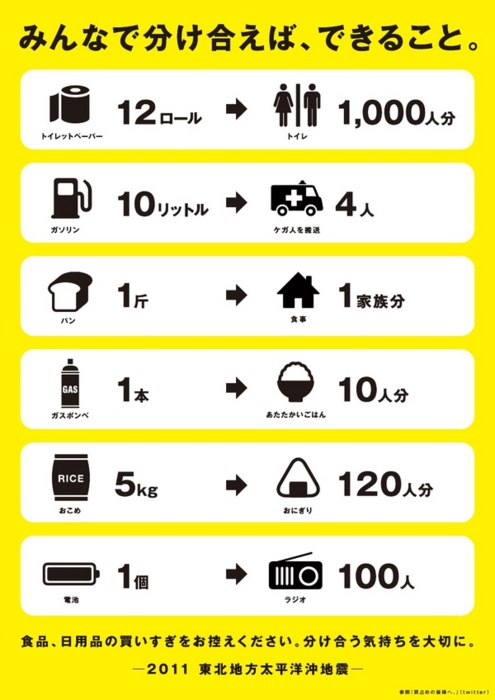
東京のみんなが協力しているのを感じます。
Thank you to everyone who has reached out to inquire about Tokyo and its residents’ wellbeing this week. We appreciate that so many people are helping with the rescue and recovery.
I saw this Tokyo conservation poster online. It’s good to focus on conservation and sharing while tolerating the after-shocks and nuclear radiation fears. Tokyo was very fortunate compared to the horrible destruction in the north, with almost 20,000 missing and dead and 500,000 homeless.
The Tokyo cityscape is much darker at night. Outdoor signage, video screens and billboards have been turned off. It seems everyone is pulling together.
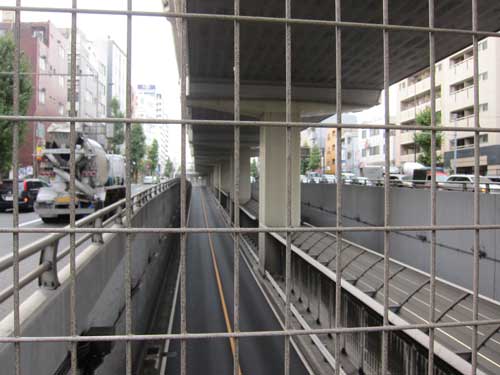
Is dead corridor the opposite of green corridor? What are the effects of urban highways?
死んでいるような交通ルートは緑の交通ルート『green corridor」の反対ですか?都市の高速道路はどんな影響をあたえるでしょうか?
Many landscape architects and urban biodiversity planners talk about the value of green corridors: places that provide wildlife shelter, that connect neighborhoods, integrate city and country, and mitigate the heat island effect. What should we call the multi-level roadways that are in many ways the opposite, that divide neighborhoods and reduce life? Dead corridors?
I took this photo on Linus Yng’s architecture bike tour; I think it’s near Sasazuka. It’s very close to the lovely remnant of the Tamagawa josui (玉川上水). I think the image makes an interesting contrast with the serenity of the train photos from yesterday’s post.
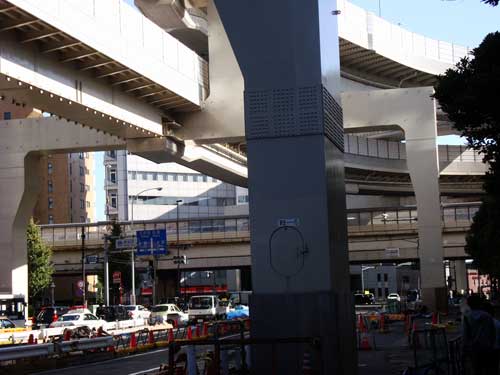
In front of Shinjuku’s Opera City, a high rise office tower with cultural facilities including theaters and a museum, four levels of stacked freeways cast shadows, pollute the air, and block pedestrian space with giant concrete support columns. The presence of even one elevated freeway undermines pedestrian life and divides neighborhoods. Are all the elevated freeways necessary for Tokyo?
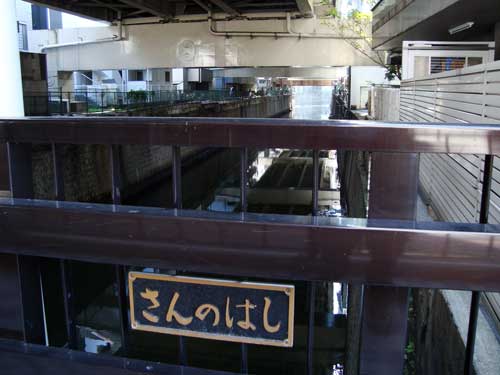
On my way to Temple University, I passed the Sannohashi bridge, and realized that the river was almost completely covered by an elevated freeway. Later I learned the river is called Furukawa (古川), an extension of the Shibuyakawa.
The freeway destroys all the life the river could support, and also diminishes the value of the houses left in its shadows.
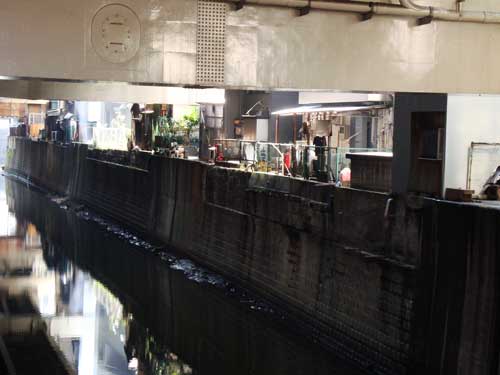
This is just one of many Tokyo rivers, canals and historic bridges buried by freeways. A hopeful vision of what could be is seen in the “daylighting” of Seoul’s Cheonggyecheon (Hangul: 청계천) river. As it is now, what remains of the river is a dead space created through poor planning.
The Tokyo Metropolitan Government’s Bureau of Construction has a cool interactive map showing every bridge of this river, with photos of each bridge and the views upstream and downstream. And there are photos of this river during Edo, Meiji and contemporary times.
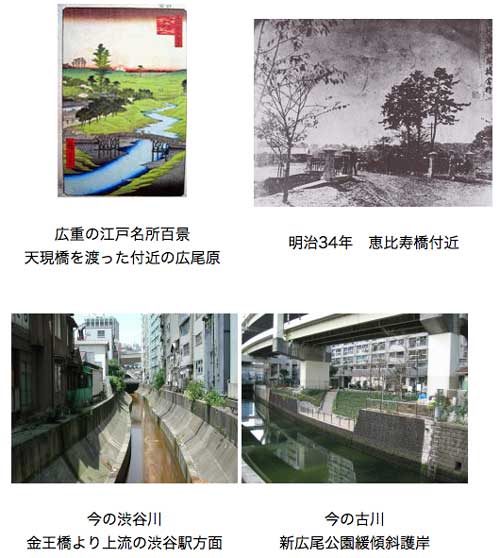
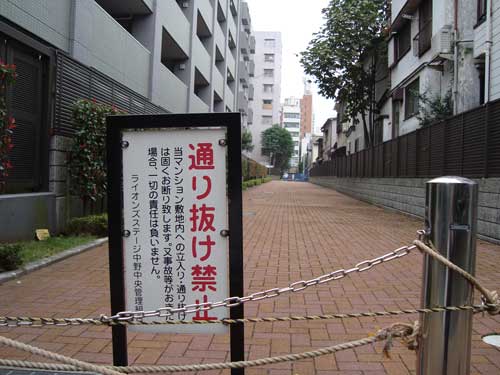
This five or ten year old residential mid-rise residential building is surrounded on two sides by hardscaped alleys that provide fire access. This design intentionally creates dead space since the developers chose not to allow pedestrian traffic. Nor did they create any amenity that would attract residents. Perhaps it keeps the apartments quieter, but this space is effectively dead for the public and even the residents.
This is a larger scale version of my previous post about dead space featuring fenced-in concrete triangles created to prevent bike parking near a Metro entrance and on a walking path, and excess pavement between houses.
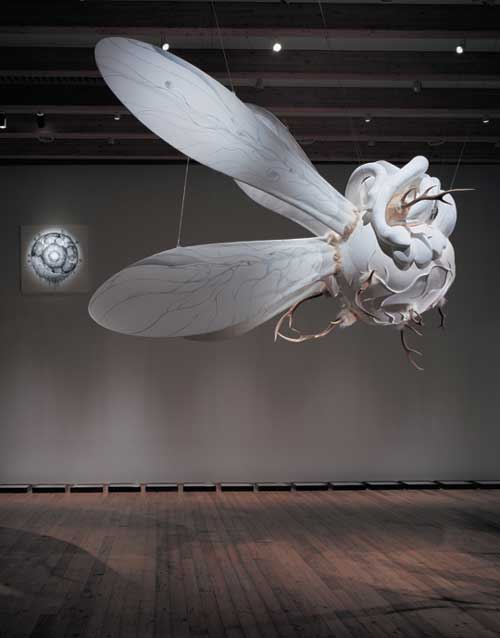
I recently visited Konoike Tomoko’s (鴻池朋子) immersive retrsopective show called Inter-Traveller at the Tokyo Opera City Art Gallery. Presented as a child-like journey to the center of the earth, Konoike’s art creates a universe of myths in which nature and humans become merged in fantasy: six-legged wolves, wolves and butterflies with young girl’s legs and red running shoes, volcanoes with human faces, a fuzzy ball character with legs and no head, a giant ball with antlers and wings and human birth, swords, and giant books.
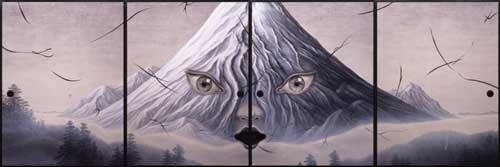
This first comprehensive exhibit include pencil on paper, painting, fusuma screens, installations, animations, and sculpture. Some rooms are entered by very low passage ways, and the second to last room has a giant spinning baby’s head covered in mirrors, surrounded by mariners’ ropes and broken glass. The movement of light around the room made me hold on to the railing with intense vertigo. The final room almost forces the visitor to confront nature and death in a tangible way; fortunately there was a discreet side escape for the squeamish.
I mention Konoike’s work because her wonderous myth-making projects a vision of humans in a state of crisis and seeking meaning through nature, mystery and travel. Just as some argue that most agricultural invention and technology comes from cities, I felt that Konoike’s art, while drawing on the natural world and spirits, is deeply urban and contemporary. The journey to the center of the earth and to rebirth, she suggest, involves imagination, play and communication between the living and the dead. I was not surprised to learn that her atelier is in one of the world’s most urban locations, Akihabara, and that her background includes toy and character design along with fine arts.
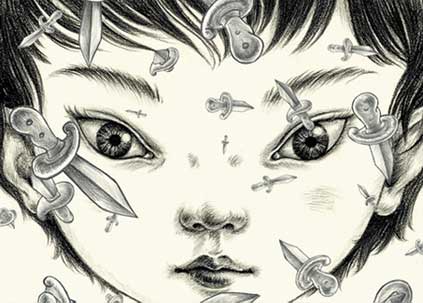

This week is Japan’s Obon festival, a Japanese Buddhist custom of honoring ancestors’ spirits. Mid-August is a time when many Japanese take vacation, some to visit their home towns and others simply to get away or take a rest. Obon is a 500 year tradition that includes offerings in home altars, special dances and lantern festivals.
The date varies by region and by neighborhood. Tsukudajima had its festival in mid-July. The shift in the timing of the Obon festival is discussed by Nagai Kafū in his Tidings from Okubo. Kafū laments the change from fall to summer, from lunar to solar calendars, and from agricultural Edo to modern “careless” Tokyo.
After three days of rain, autumn suddenly deepens. Not waiting for the night, the crickets sing their loudest under the verandas. Their singing somehow brings to mind a Japanese wife of old, sad and yet alluring, at work on her husband’s clothes in the dim light of a paper lantern. . . . Under the old lunar calendar the festival of the dead came at the beginning of autumn. Every unfilial son, however profligate and however forgetful of home he might have been on ordinary occasions, must have thought of his dead mother and father in the sadness of the autumn dews. But now we have imitated the West and adopted the solar calendar, and the festival comes just after the June rains or toward the middle of the summer. The sadness with which the dead ought to be remembered is wholly lacking. The morals of a country are in danger when they are cut loose from the beauty of its soil and its seasons. The makers of our new age have been careless in many ways.” (p 238, Edward Seidensticker’s Kafū the Scribbler: The Life and Writing of Nagai Kafū, 1879-1959, Stanford University Press, 1965).
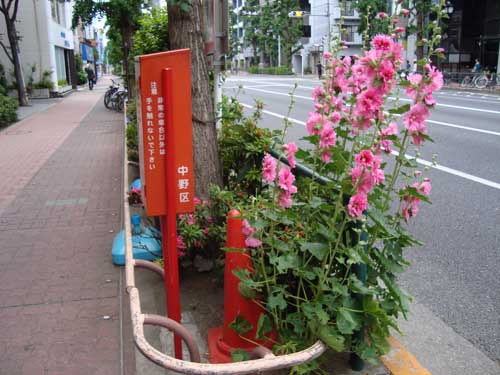
Above is a photo of a Nakano sidewalk on a busy boulevard. Between pedestrians and the street is an organized planted green strip with railing, ginko trees and azalea bushes. In May, seemingly out of nowhere, giant pink hollyhocks have appeared. What is amazing is that they extend over 1 kilometer on the sunny north side of the boulevard. Someone must have planted a few, which then went viral.
Below is a sidewalk and street in Odaiba, with corporate planting on the left and public planting on the right. Despite the greater green quotient, this Odaiba sidewalk is generally lacking in street traffic, pedestrian traffic and any un-planned greenery. There is something dead and sad about these streets, where large convention centers, a few offices and shopping malls are interspersed with empty lots.
